Audit Plan for Trunkey Creek Wines: Financial Accounting Analysis
VerifiedAdded on 2023/06/04
|14
|2189
|384
Report
AI Summary
This report details an audit plan for Trunkey Creek Wines (TCW), a significant client of Miller Yates Howarth (MYH). The report analyzes various financial aspects, including accounts receivable, property assets, and marketing expenses, using ratio analysis to assess audit risks. It evaluates the effectiveness of TCW's internal control system, identifies weaknesses in accounts payable and purchase accounts, and recommends audit procedures to mitigate identified risks. The analysis covers the period ending June 30, 2018, comparing financial data with previous years to identify trends and potential areas of concern. The report provides a comprehensive overview of the audit process, addressing key areas of financial accounting and internal controls to ensure the accuracy and reliability of TCW's financial statements.
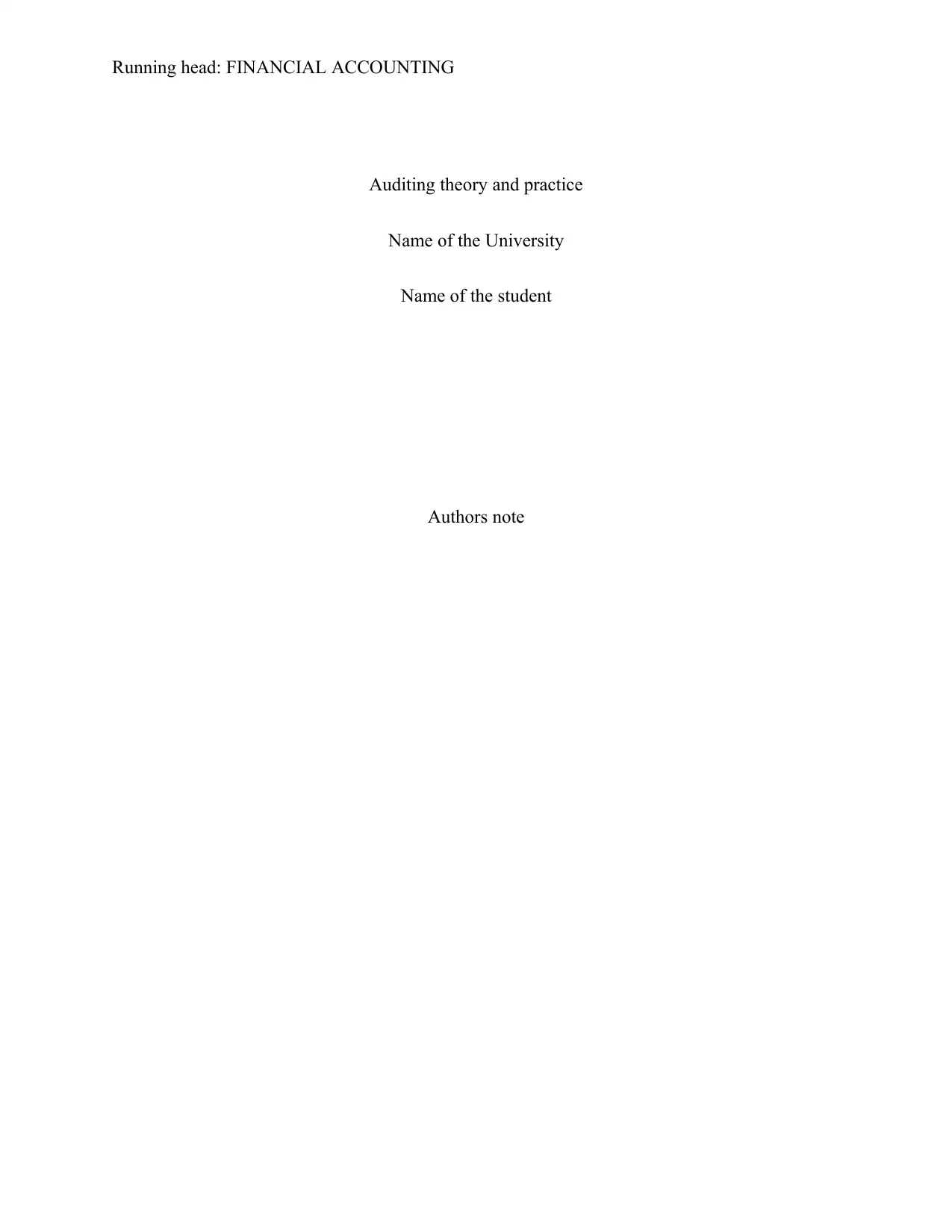
Running head: FINANCIAL ACCOUNTING
Auditing theory and practice
Name of the University
Name of the student
Authors note
Auditing theory and practice
Name of the University
Name of the student
Authors note
Paraphrase This Document
Need a fresh take? Get an instant paraphrase of this document with our AI Paraphraser
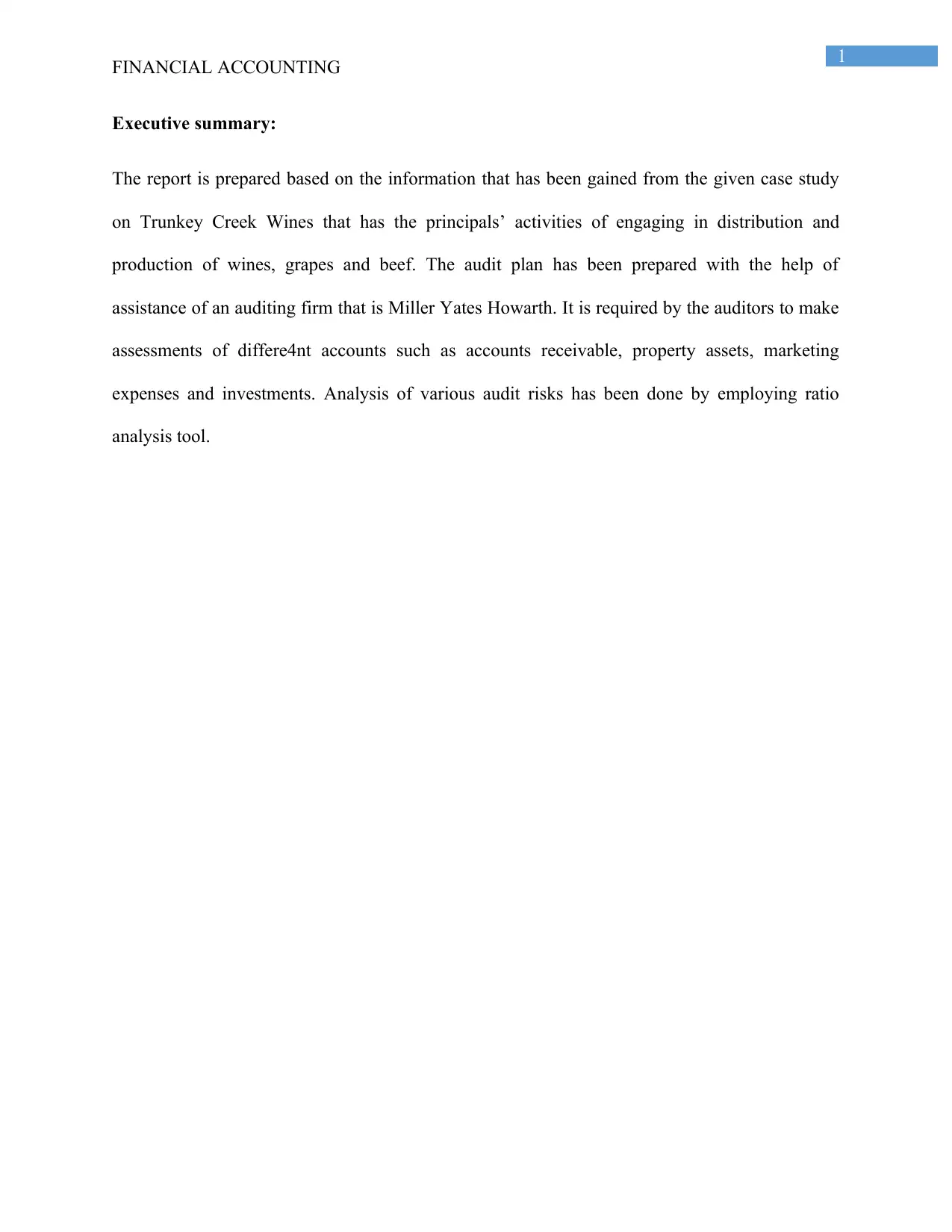
1
FINANCIAL ACCOUNTING
Executive summary:
The report is prepared based on the information that has been gained from the given case study
on Trunkey Creek Wines that has the principals’ activities of engaging in distribution and
production of wines, grapes and beef. The audit plan has been prepared with the help of
assistance of an auditing firm that is Miller Yates Howarth. It is required by the auditors to make
assessments of differe4nt accounts such as accounts receivable, property assets, marketing
expenses and investments. Analysis of various audit risks has been done by employing ratio
analysis tool.
FINANCIAL ACCOUNTING
Executive summary:
The report is prepared based on the information that has been gained from the given case study
on Trunkey Creek Wines that has the principals’ activities of engaging in distribution and
production of wines, grapes and beef. The audit plan has been prepared with the help of
assistance of an auditing firm that is Miller Yates Howarth. It is required by the auditors to make
assessments of differe4nt accounts such as accounts receivable, property assets, marketing
expenses and investments. Analysis of various audit risks has been done by employing ratio
analysis tool.
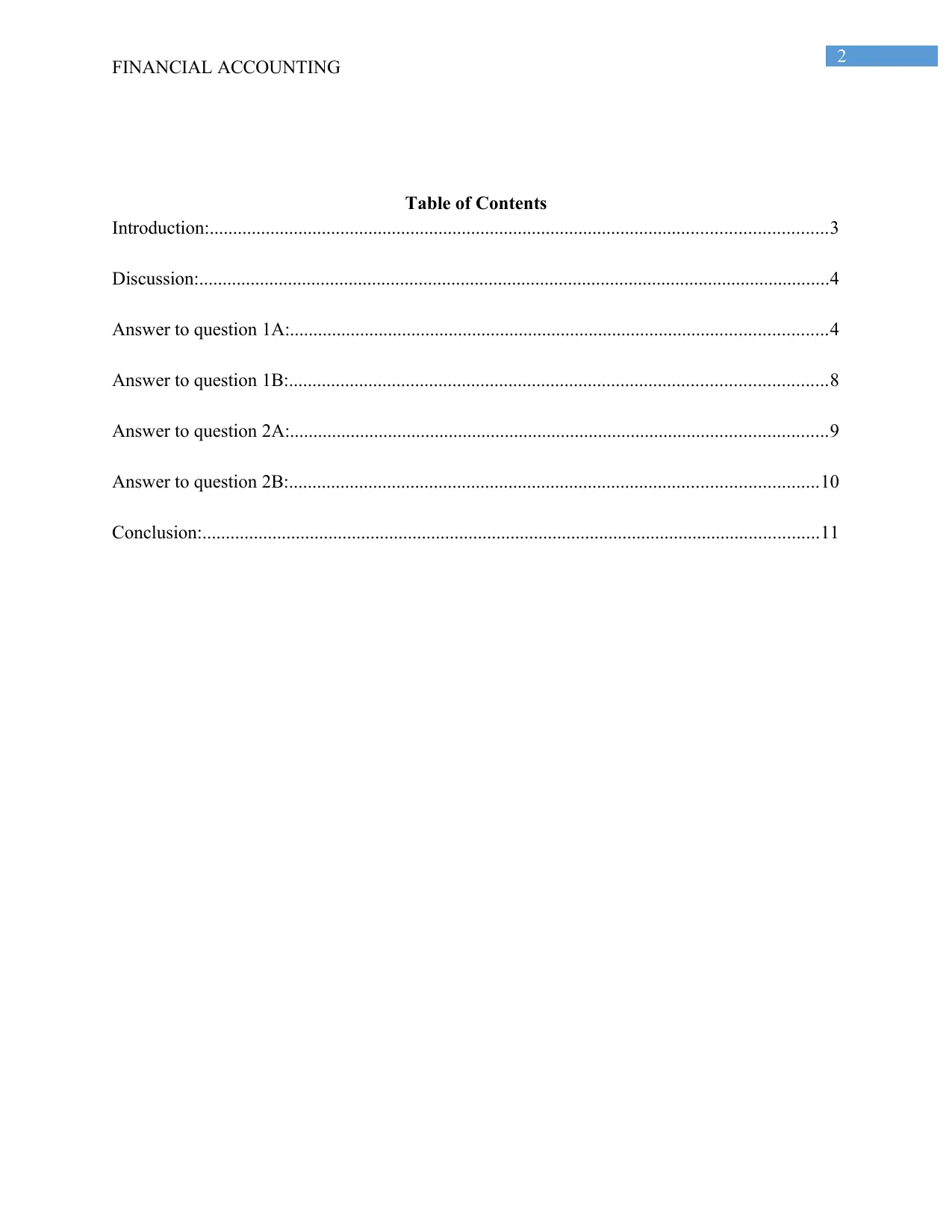
2
FINANCIAL ACCOUNTING
Table of Contents
Introduction:....................................................................................................................................3
Discussion:.......................................................................................................................................4
Answer to question 1A:...................................................................................................................4
Answer to question 1B:...................................................................................................................8
Answer to question 2A:...................................................................................................................9
Answer to question 2B:.................................................................................................................10
Conclusion:....................................................................................................................................11
FINANCIAL ACCOUNTING
Table of Contents
Introduction:....................................................................................................................................3
Discussion:.......................................................................................................................................4
Answer to question 1A:...................................................................................................................4
Answer to question 1B:...................................................................................................................8
Answer to question 2A:...................................................................................................................9
Answer to question 2B:.................................................................................................................10
Conclusion:....................................................................................................................................11
⊘ This is a preview!⊘
Do you want full access?
Subscribe today to unlock all pages.

Trusted by 1+ million students worldwide
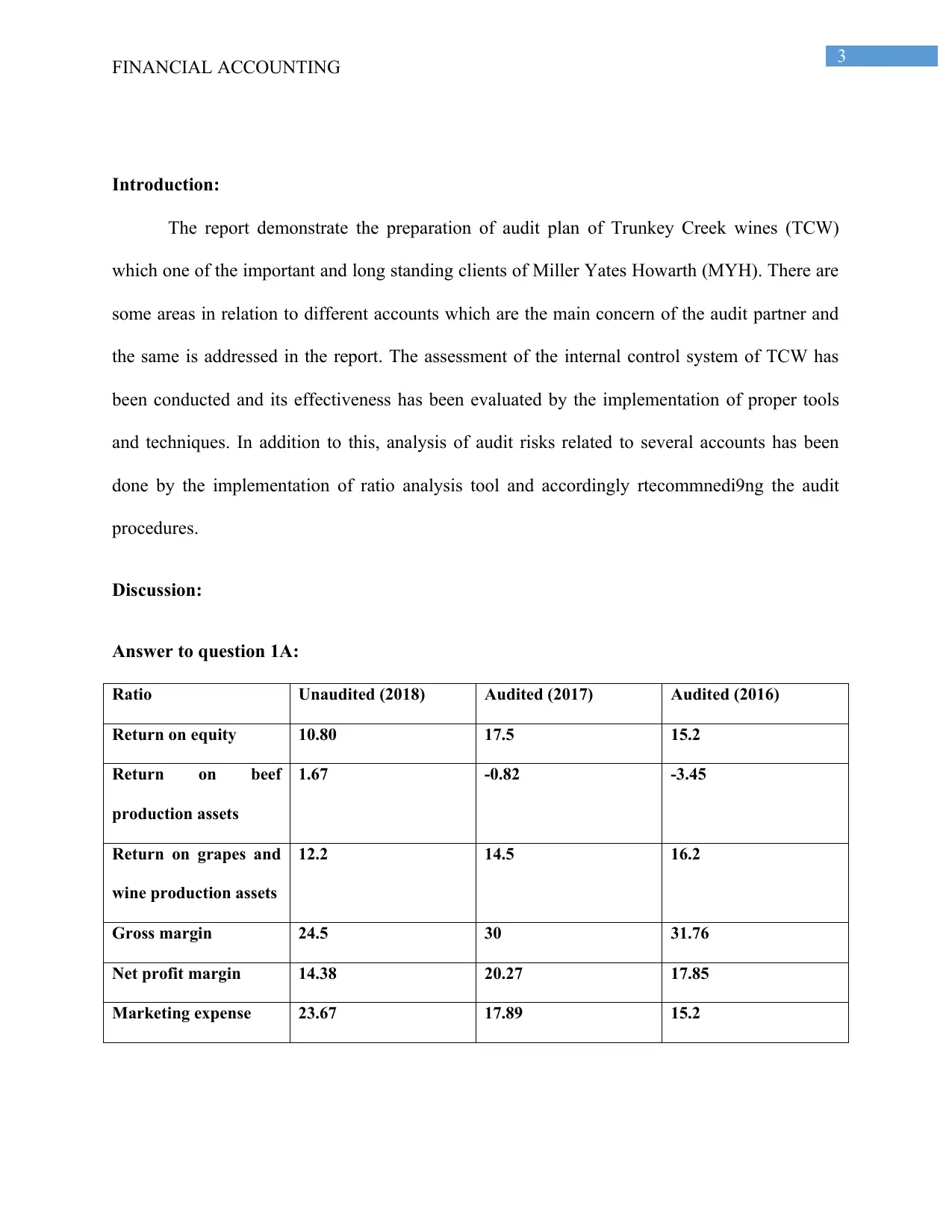
3
FINANCIAL ACCOUNTING
Introduction:
The report demonstrate the preparation of audit plan of Trunkey Creek wines (TCW)
which one of the important and long standing clients of Miller Yates Howarth (MYH). There are
some areas in relation to different accounts which are the main concern of the audit partner and
the same is addressed in the report. The assessment of the internal control system of TCW has
been conducted and its effectiveness has been evaluated by the implementation of proper tools
and techniques. In addition to this, analysis of audit risks related to several accounts has been
done by the implementation of ratio analysis tool and accordingly rtecommnedi9ng the audit
procedures.
Discussion:
Answer to question 1A:
Ratio Unaudited (2018) Audited (2017) Audited (2016)
Return on equity 10.80 17.5 15.2
Return on beef
production assets
1.67 -0.82 -3.45
Return on grapes and
wine production assets
12.2 14.5 16.2
Gross margin 24.5 30 31.76
Net profit margin 14.38 20.27 17.85
Marketing expense 23.67 17.89 15.2
FINANCIAL ACCOUNTING
Introduction:
The report demonstrate the preparation of audit plan of Trunkey Creek wines (TCW)
which one of the important and long standing clients of Miller Yates Howarth (MYH). There are
some areas in relation to different accounts which are the main concern of the audit partner and
the same is addressed in the report. The assessment of the internal control system of TCW has
been conducted and its effectiveness has been evaluated by the implementation of proper tools
and techniques. In addition to this, analysis of audit risks related to several accounts has been
done by the implementation of ratio analysis tool and accordingly rtecommnedi9ng the audit
procedures.
Discussion:
Answer to question 1A:
Ratio Unaudited (2018) Audited (2017) Audited (2016)
Return on equity 10.80 17.5 15.2
Return on beef
production assets
1.67 -0.82 -3.45
Return on grapes and
wine production assets
12.2 14.5 16.2
Gross margin 24.5 30 31.76
Net profit margin 14.38 20.27 17.85
Marketing expense 23.67 17.89 15.2
Paraphrase This Document
Need a fresh take? Get an instant paraphrase of this document with our AI Paraphraser
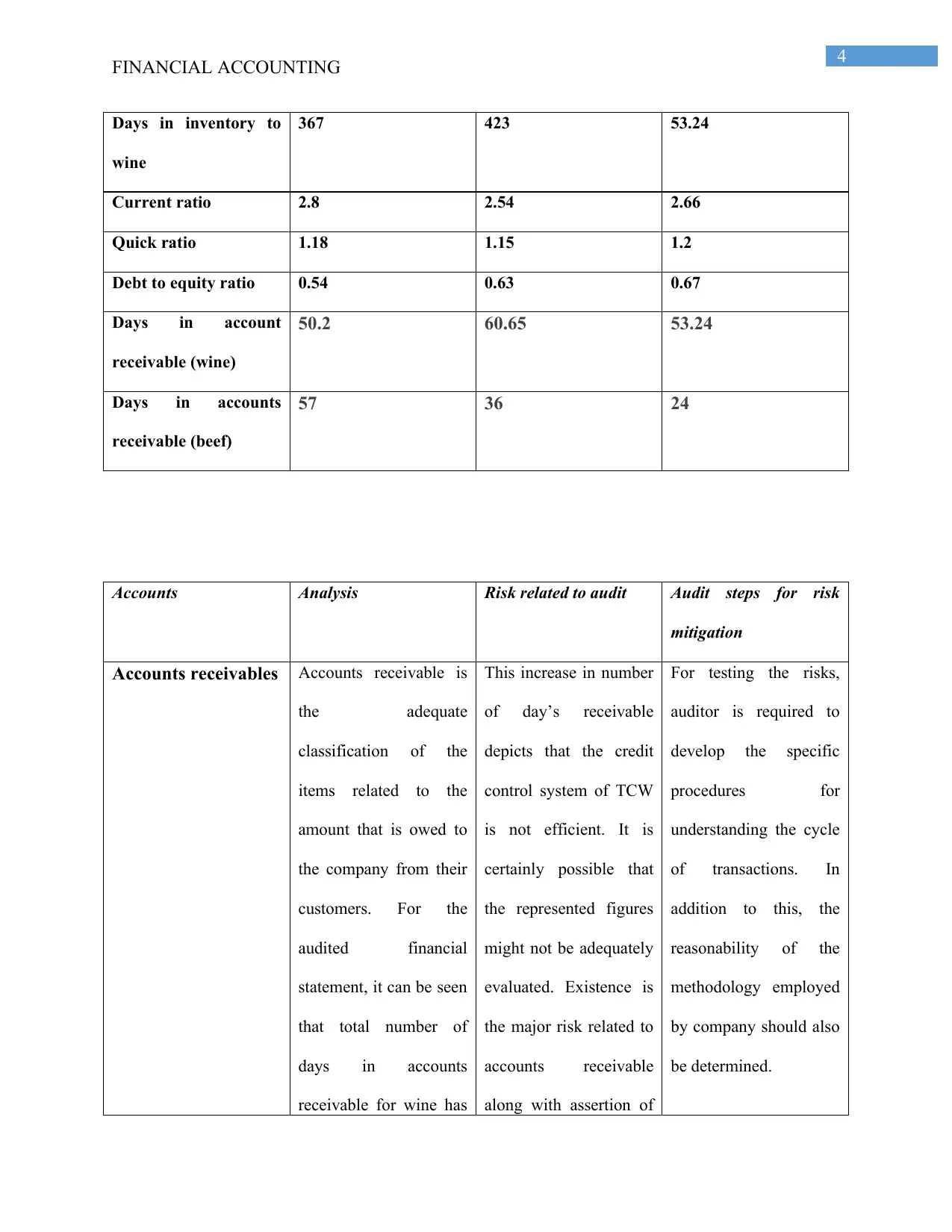
4
FINANCIAL ACCOUNTING
Days in inventory to
wine
367 423 53.24
Current ratio 2.8 2.54 2.66
Quick ratio 1.18 1.15 1.2
Debt to equity ratio 0.54 0.63 0.67
Days in account
receivable (wine)
50.2 60.65 53.24
Days in accounts
receivable (beef)
57 36 24
Accounts Analysis Risk related to audit Audit steps for risk
mitigation
Accounts receivables Accounts receivable is
the adequate
classification of the
items related to the
amount that is owed to
the company from their
customers. For the
audited financial
statement, it can be seen
that total number of
days in accounts
receivable for wine has
This increase in number
of day’s receivable
depicts that the credit
control system of TCW
is not efficient. It is
certainly possible that
the represented figures
might not be adequately
evaluated. Existence is
the major risk related to
accounts receivable
along with assertion of
For testing the risks,
auditor is required to
develop the specific
procedures for
understanding the cycle
of transactions. In
addition to this, the
reasonability of the
methodology employed
by company should also
be determined.
FINANCIAL ACCOUNTING
Days in inventory to
wine
367 423 53.24
Current ratio 2.8 2.54 2.66
Quick ratio 1.18 1.15 1.2
Debt to equity ratio 0.54 0.63 0.67
Days in account
receivable (wine)
50.2 60.65 53.24
Days in accounts
receivable (beef)
57 36 24
Accounts Analysis Risk related to audit Audit steps for risk
mitigation
Accounts receivables Accounts receivable is
the adequate
classification of the
items related to the
amount that is owed to
the company from their
customers. For the
audited financial
statement, it can be seen
that total number of
days in accounts
receivable for wine has
This increase in number
of day’s receivable
depicts that the credit
control system of TCW
is not efficient. It is
certainly possible that
the represented figures
might not be adequately
evaluated. Existence is
the major risk related to
accounts receivable
along with assertion of
For testing the risks,
auditor is required to
develop the specific
procedures for
understanding the cycle
of transactions. In
addition to this, the
reasonability of the
methodology employed
by company should also
be determined.
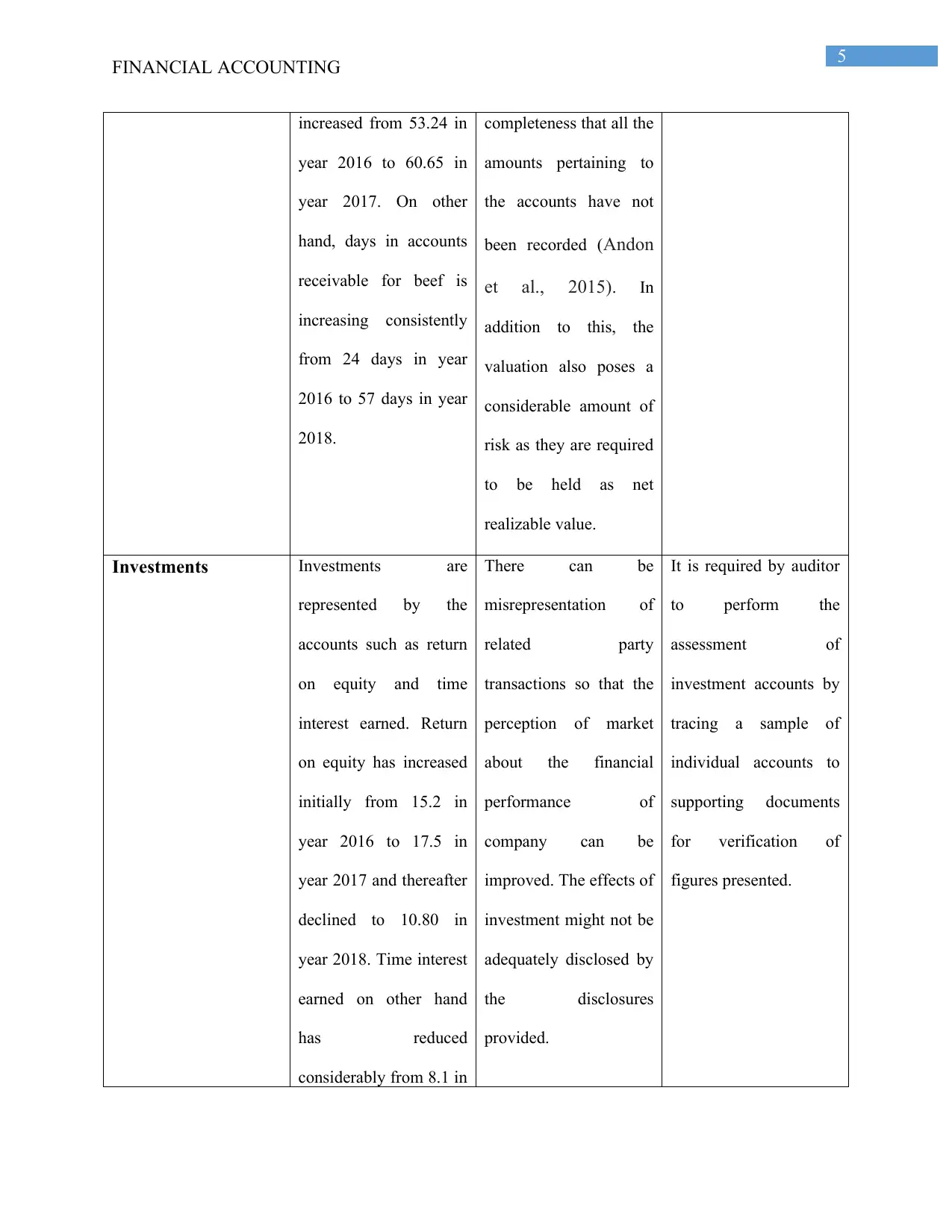
5
FINANCIAL ACCOUNTING
increased from 53.24 in
year 2016 to 60.65 in
year 2017. On other
hand, days in accounts
receivable for beef is
increasing consistently
from 24 days in year
2016 to 57 days in year
2018.
completeness that all the
amounts pertaining to
the accounts have not
been recorded (Andon
et al., 2015). In
addition to this, the
valuation also poses a
considerable amount of
risk as they are required
to be held as net
realizable value.
Investments Investments are
represented by the
accounts such as return
on equity and time
interest earned. Return
on equity has increased
initially from 15.2 in
year 2016 to 17.5 in
year 2017 and thereafter
declined to 10.80 in
year 2018. Time interest
earned on other hand
has reduced
considerably from 8.1 in
There can be
misrepresentation of
related party
transactions so that the
perception of market
about the financial
performance of
company can be
improved. The effects of
investment might not be
adequately disclosed by
the disclosures
provided.
It is required by auditor
to perform the
assessment of
investment accounts by
tracing a sample of
individual accounts to
supporting documents
for verification of
figures presented.
FINANCIAL ACCOUNTING
increased from 53.24 in
year 2016 to 60.65 in
year 2017. On other
hand, days in accounts
receivable for beef is
increasing consistently
from 24 days in year
2016 to 57 days in year
2018.
completeness that all the
amounts pertaining to
the accounts have not
been recorded (Andon
et al., 2015). In
addition to this, the
valuation also poses a
considerable amount of
risk as they are required
to be held as net
realizable value.
Investments Investments are
represented by the
accounts such as return
on equity and time
interest earned. Return
on equity has increased
initially from 15.2 in
year 2016 to 17.5 in
year 2017 and thereafter
declined to 10.80 in
year 2018. Time interest
earned on other hand
has reduced
considerably from 8.1 in
There can be
misrepresentation of
related party
transactions so that the
perception of market
about the financial
performance of
company can be
improved. The effects of
investment might not be
adequately disclosed by
the disclosures
provided.
It is required by auditor
to perform the
assessment of
investment accounts by
tracing a sample of
individual accounts to
supporting documents
for verification of
figures presented.
⊘ This is a preview!⊘
Do you want full access?
Subscribe today to unlock all pages.

Trusted by 1+ million students worldwide
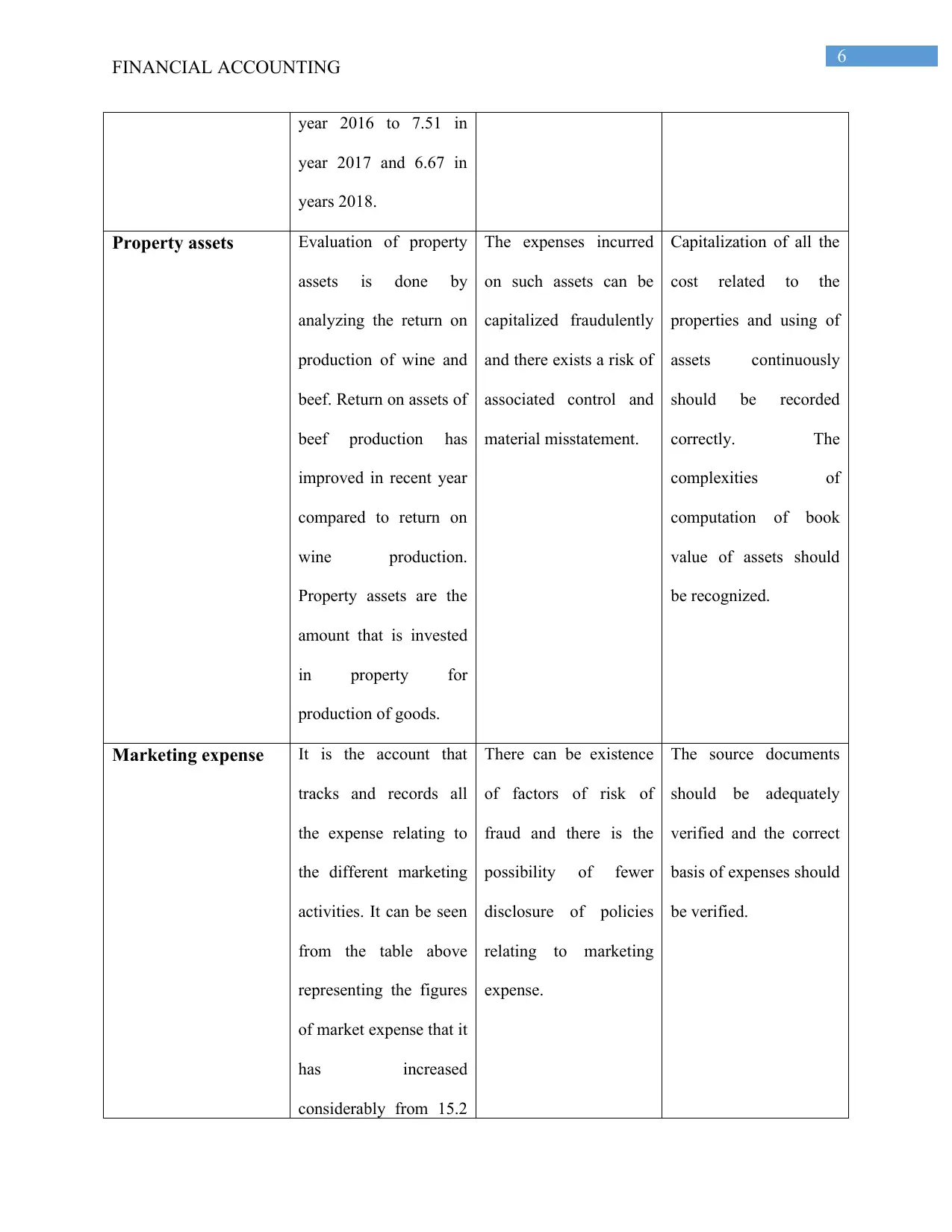
6
FINANCIAL ACCOUNTING
year 2016 to 7.51 in
year 2017 and 6.67 in
years 2018.
Property assets Evaluation of property
assets is done by
analyzing the return on
production of wine and
beef. Return on assets of
beef production has
improved in recent year
compared to return on
wine production.
Property assets are the
amount that is invested
in property for
production of goods.
The expenses incurred
on such assets can be
capitalized fraudulently
and there exists a risk of
associated control and
material misstatement.
Capitalization of all the
cost related to the
properties and using of
assets continuously
should be recorded
correctly. The
complexities of
computation of book
value of assets should
be recognized.
Marketing expense It is the account that
tracks and records all
the expense relating to
the different marketing
activities. It can be seen
from the table above
representing the figures
of market expense that it
has increased
considerably from 15.2
There can be existence
of factors of risk of
fraud and there is the
possibility of fewer
disclosure of policies
relating to marketing
expense.
The source documents
should be adequately
verified and the correct
basis of expenses should
be verified.
FINANCIAL ACCOUNTING
year 2016 to 7.51 in
year 2017 and 6.67 in
years 2018.
Property assets Evaluation of property
assets is done by
analyzing the return on
production of wine and
beef. Return on assets of
beef production has
improved in recent year
compared to return on
wine production.
Property assets are the
amount that is invested
in property for
production of goods.
The expenses incurred
on such assets can be
capitalized fraudulently
and there exists a risk of
associated control and
material misstatement.
Capitalization of all the
cost related to the
properties and using of
assets continuously
should be recorded
correctly. The
complexities of
computation of book
value of assets should
be recognized.
Marketing expense It is the account that
tracks and records all
the expense relating to
the different marketing
activities. It can be seen
from the table above
representing the figures
of market expense that it
has increased
considerably from 15.2
There can be existence
of factors of risk of
fraud and there is the
possibility of fewer
disclosure of policies
relating to marketing
expense.
The source documents
should be adequately
verified and the correct
basis of expenses should
be verified.
Paraphrase This Document
Need a fresh take? Get an instant paraphrase of this document with our AI Paraphraser
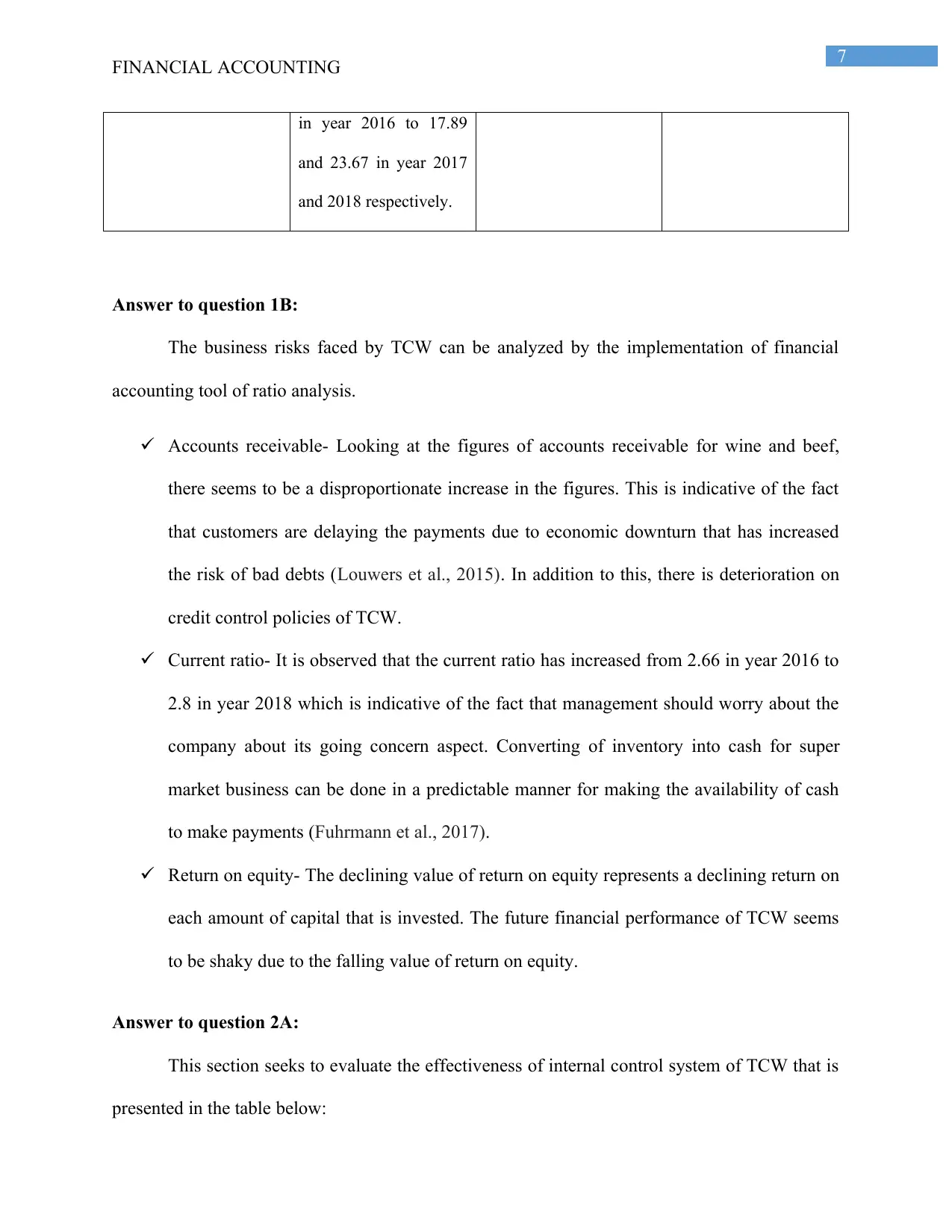
7
FINANCIAL ACCOUNTING
in year 2016 to 17.89
and 23.67 in year 2017
and 2018 respectively.
Answer to question 1B:
The business risks faced by TCW can be analyzed by the implementation of financial
accounting tool of ratio analysis.
Accounts receivable- Looking at the figures of accounts receivable for wine and beef,
there seems to be a disproportionate increase in the figures. This is indicative of the fact
that customers are delaying the payments due to economic downturn that has increased
the risk of bad debts (Louwers et al., 2015). In addition to this, there is deterioration on
credit control policies of TCW.
Current ratio- It is observed that the current ratio has increased from 2.66 in year 2016 to
2.8 in year 2018 which is indicative of the fact that management should worry about the
company about its going concern aspect. Converting of inventory into cash for super
market business can be done in a predictable manner for making the availability of cash
to make payments (Fuhrmann et al., 2017).
Return on equity- The declining value of return on equity represents a declining return on
each amount of capital that is invested. The future financial performance of TCW seems
to be shaky due to the falling value of return on equity.
Answer to question 2A:
This section seeks to evaluate the effectiveness of internal control system of TCW that is
presented in the table below:
FINANCIAL ACCOUNTING
in year 2016 to 17.89
and 23.67 in year 2017
and 2018 respectively.
Answer to question 1B:
The business risks faced by TCW can be analyzed by the implementation of financial
accounting tool of ratio analysis.
Accounts receivable- Looking at the figures of accounts receivable for wine and beef,
there seems to be a disproportionate increase in the figures. This is indicative of the fact
that customers are delaying the payments due to economic downturn that has increased
the risk of bad debts (Louwers et al., 2015). In addition to this, there is deterioration on
credit control policies of TCW.
Current ratio- It is observed that the current ratio has increased from 2.66 in year 2016 to
2.8 in year 2018 which is indicative of the fact that management should worry about the
company about its going concern aspect. Converting of inventory into cash for super
market business can be done in a predictable manner for making the availability of cash
to make payments (Fuhrmann et al., 2017).
Return on equity- The declining value of return on equity represents a declining return on
each amount of capital that is invested. The future financial performance of TCW seems
to be shaky due to the falling value of return on equity.
Answer to question 2A:
This section seeks to evaluate the effectiveness of internal control system of TCW that is
presented in the table below:
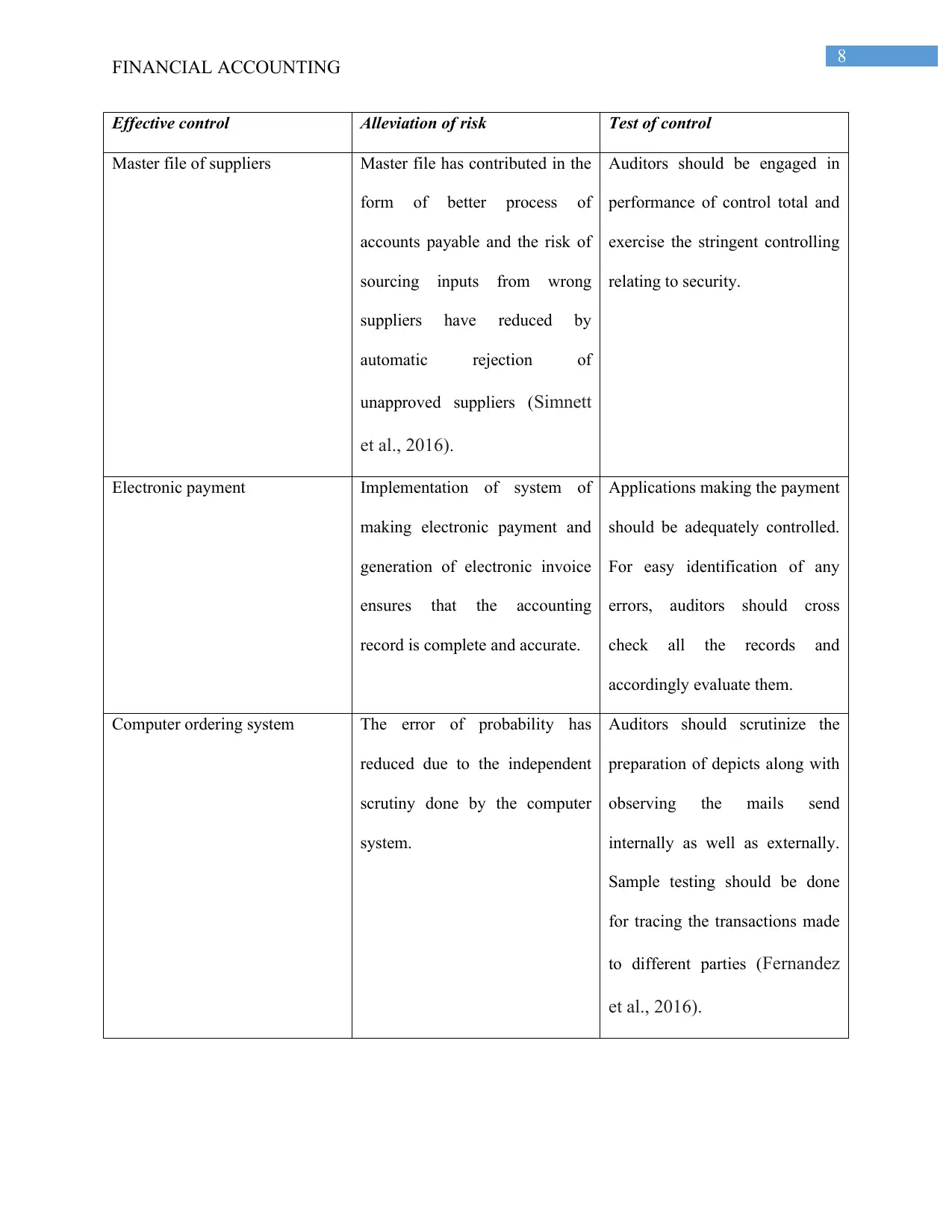
8
FINANCIAL ACCOUNTING
Effective control Alleviation of risk Test of control
Master file of suppliers Master file has contributed in the
form of better process of
accounts payable and the risk of
sourcing inputs from wrong
suppliers have reduced by
automatic rejection of
unapproved suppliers (Simnett
et al., 2016).
Auditors should be engaged in
performance of control total and
exercise the stringent controlling
relating to security.
Electronic payment Implementation of system of
making electronic payment and
generation of electronic invoice
ensures that the accounting
record is complete and accurate.
Applications making the payment
should be adequately controlled.
For easy identification of any
errors, auditors should cross
check all the records and
accordingly evaluate them.
Computer ordering system The error of probability has
reduced due to the independent
scrutiny done by the computer
system.
Auditors should scrutinize the
preparation of depicts along with
observing the mails send
internally as well as externally.
Sample testing should be done
for tracing the transactions made
to different parties (Fernandez
et al., 2016).
FINANCIAL ACCOUNTING
Effective control Alleviation of risk Test of control
Master file of suppliers Master file has contributed in the
form of better process of
accounts payable and the risk of
sourcing inputs from wrong
suppliers have reduced by
automatic rejection of
unapproved suppliers (Simnett
et al., 2016).
Auditors should be engaged in
performance of control total and
exercise the stringent controlling
relating to security.
Electronic payment Implementation of system of
making electronic payment and
generation of electronic invoice
ensures that the accounting
record is complete and accurate.
Applications making the payment
should be adequately controlled.
For easy identification of any
errors, auditors should cross
check all the records and
accordingly evaluate them.
Computer ordering system The error of probability has
reduced due to the independent
scrutiny done by the computer
system.
Auditors should scrutinize the
preparation of depicts along with
observing the mails send
internally as well as externally.
Sample testing should be done
for tracing the transactions made
to different parties (Fernandez
et al., 2016).
⊘ This is a preview!⊘
Do you want full access?
Subscribe today to unlock all pages.

Trusted by 1+ million students worldwide
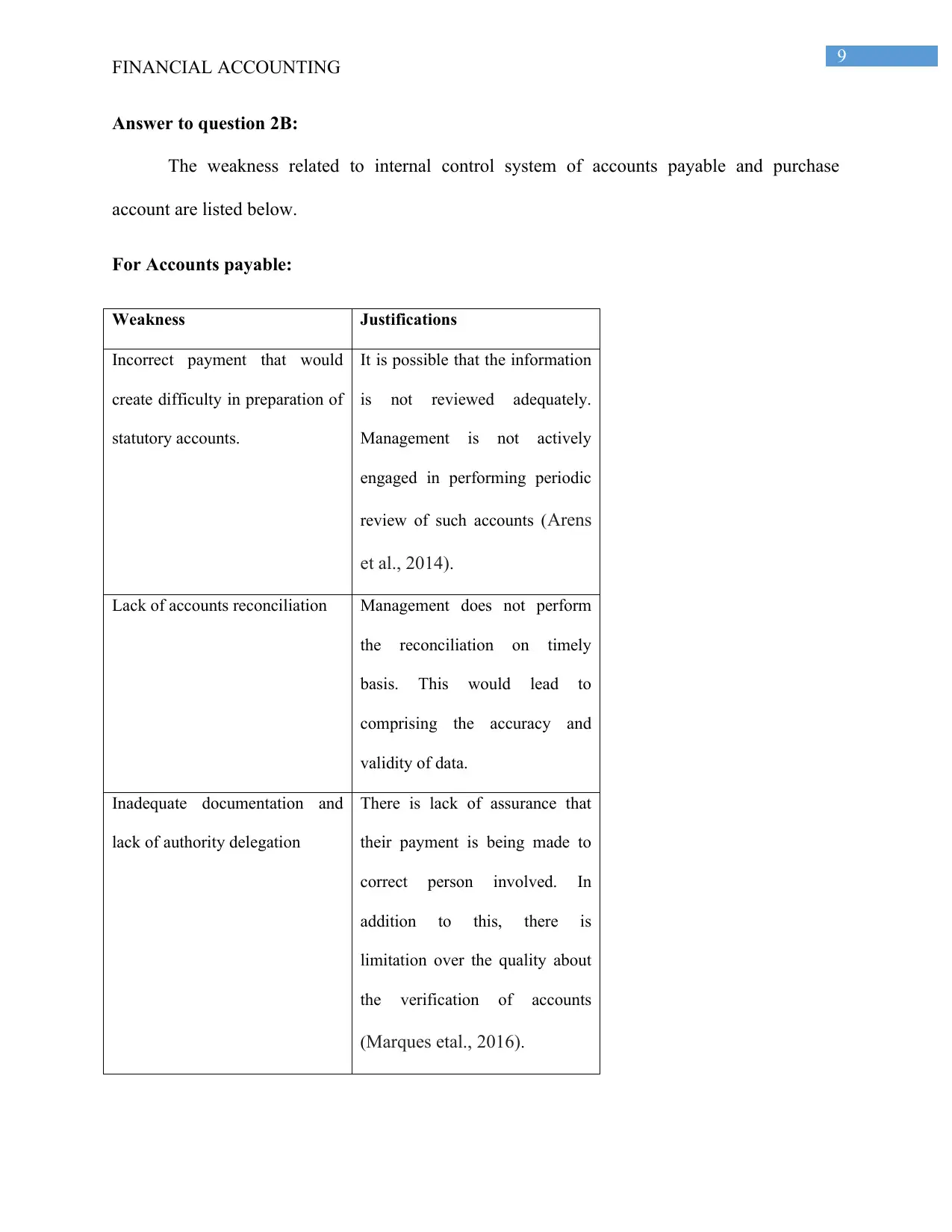
9
FINANCIAL ACCOUNTING
Answer to question 2B:
The weakness related to internal control system of accounts payable and purchase
account are listed below.
For Accounts payable:
Weakness Justifications
Incorrect payment that would
create difficulty in preparation of
statutory accounts.
It is possible that the information
is not reviewed adequately.
Management is not actively
engaged in performing periodic
review of such accounts (Arens
et al., 2014).
Lack of accounts reconciliation Management does not perform
the reconciliation on timely
basis. This would lead to
comprising the accuracy and
validity of data.
Inadequate documentation and
lack of authority delegation
There is lack of assurance that
their payment is being made to
correct person involved. In
addition to this, there is
limitation over the quality about
the verification of accounts
(Marques etal., 2016).
FINANCIAL ACCOUNTING
Answer to question 2B:
The weakness related to internal control system of accounts payable and purchase
account are listed below.
For Accounts payable:
Weakness Justifications
Incorrect payment that would
create difficulty in preparation of
statutory accounts.
It is possible that the information
is not reviewed adequately.
Management is not actively
engaged in performing periodic
review of such accounts (Arens
et al., 2014).
Lack of accounts reconciliation Management does not perform
the reconciliation on timely
basis. This would lead to
comprising the accuracy and
validity of data.
Inadequate documentation and
lack of authority delegation
There is lack of assurance that
their payment is being made to
correct person involved. In
addition to this, there is
limitation over the quality about
the verification of accounts
(Marques etal., 2016).
Paraphrase This Document
Need a fresh take? Get an instant paraphrase of this document with our AI Paraphraser
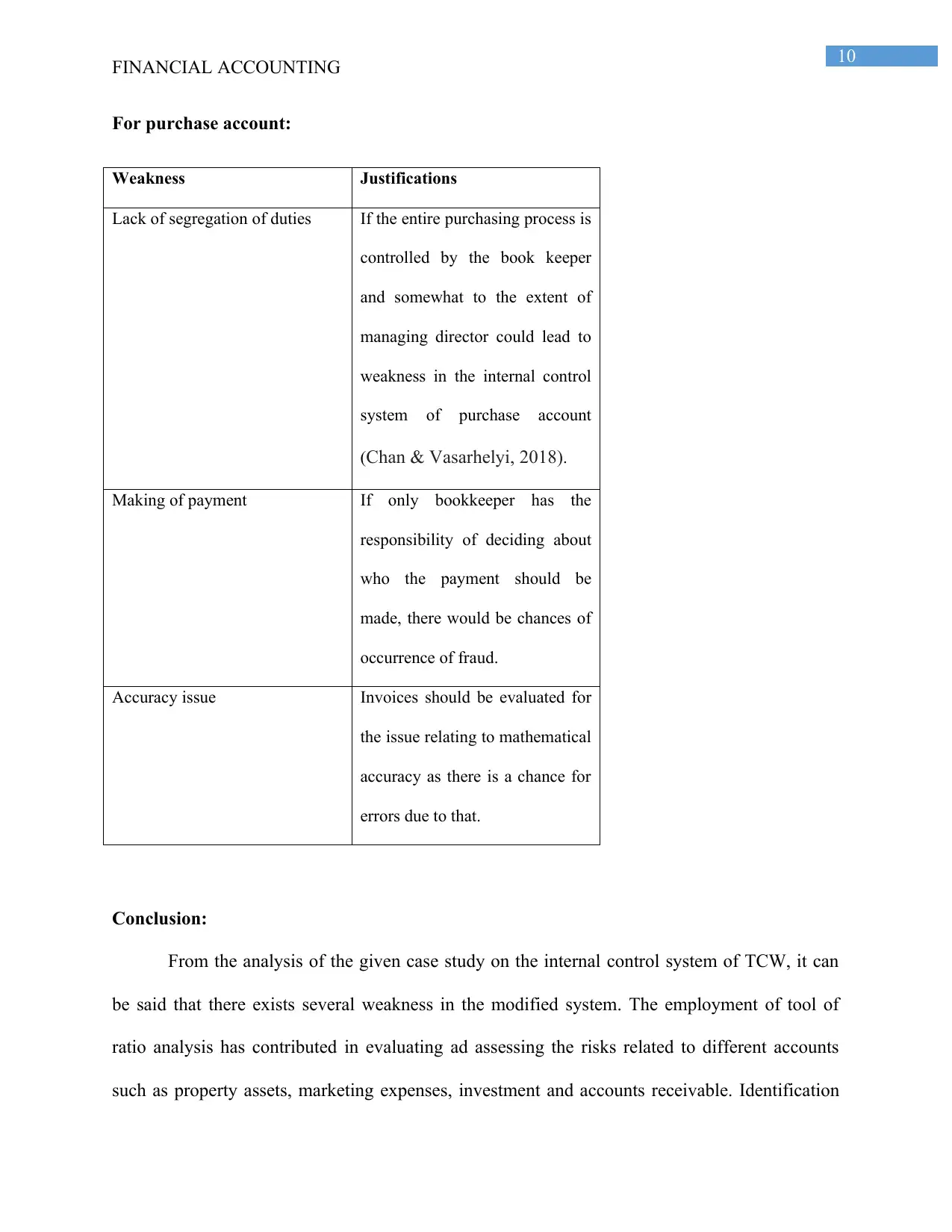
10
FINANCIAL ACCOUNTING
For purchase account:
Weakness Justifications
Lack of segregation of duties If the entire purchasing process is
controlled by the book keeper
and somewhat to the extent of
managing director could lead to
weakness in the internal control
system of purchase account
(Chan & Vasarhelyi, 2018).
Making of payment If only bookkeeper has the
responsibility of deciding about
who the payment should be
made, there would be chances of
occurrence of fraud.
Accuracy issue Invoices should be evaluated for
the issue relating to mathematical
accuracy as there is a chance for
errors due to that.
Conclusion:
From the analysis of the given case study on the internal control system of TCW, it can
be said that there exists several weakness in the modified system. The employment of tool of
ratio analysis has contributed in evaluating ad assessing the risks related to different accounts
such as property assets, marketing expenses, investment and accounts receivable. Identification
FINANCIAL ACCOUNTING
For purchase account:
Weakness Justifications
Lack of segregation of duties If the entire purchasing process is
controlled by the book keeper
and somewhat to the extent of
managing director could lead to
weakness in the internal control
system of purchase account
(Chan & Vasarhelyi, 2018).
Making of payment If only bookkeeper has the
responsibility of deciding about
who the payment should be
made, there would be chances of
occurrence of fraud.
Accuracy issue Invoices should be evaluated for
the issue relating to mathematical
accuracy as there is a chance for
errors due to that.
Conclusion:
From the analysis of the given case study on the internal control system of TCW, it can
be said that there exists several weakness in the modified system. The employment of tool of
ratio analysis has contributed in evaluating ad assessing the risks related to different accounts
such as property assets, marketing expenses, investment and accounts receivable. Identification
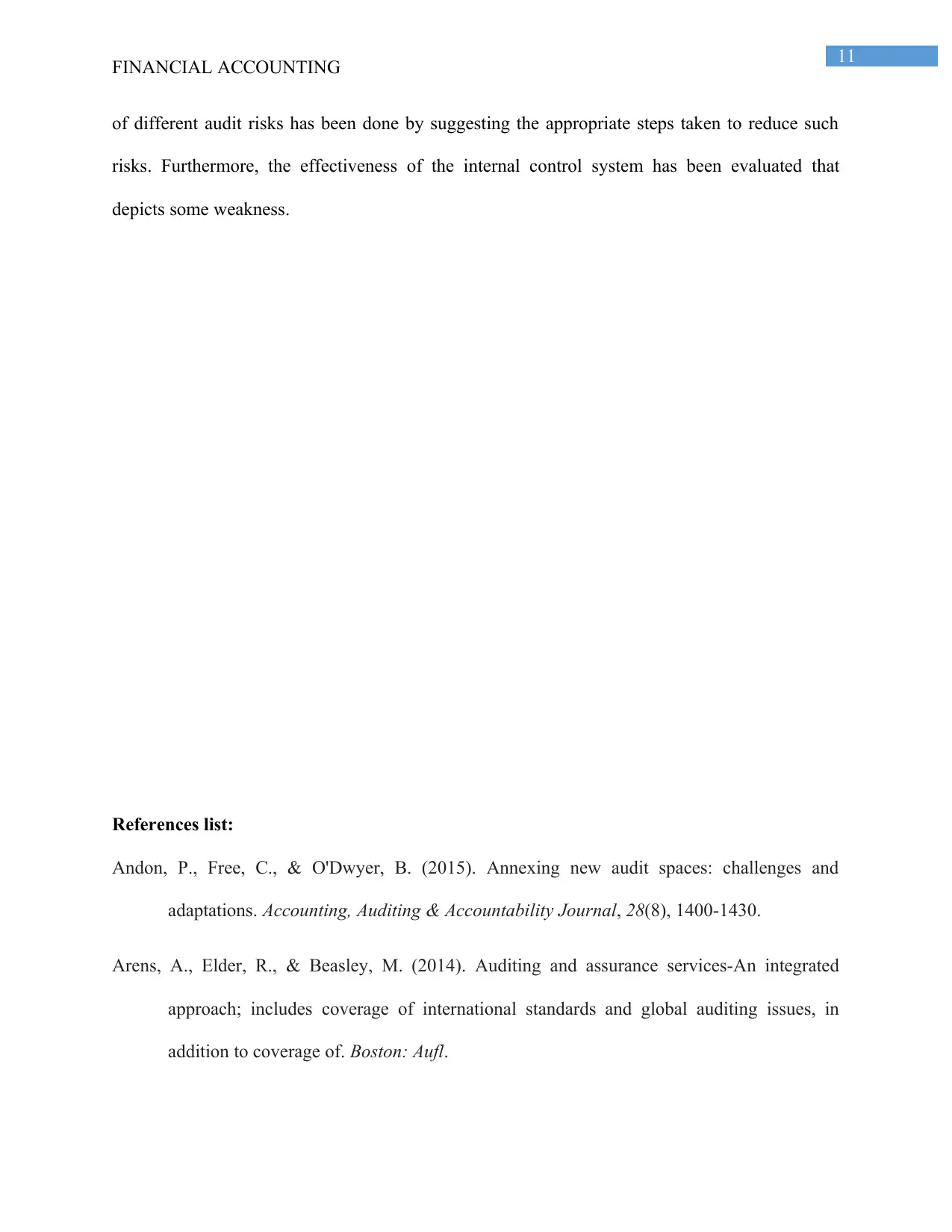
11
FINANCIAL ACCOUNTING
of different audit risks has been done by suggesting the appropriate steps taken to reduce such
risks. Furthermore, the effectiveness of the internal control system has been evaluated that
depicts some weakness.
References list:
Andon, P., Free, C., & O'Dwyer, B. (2015). Annexing new audit spaces: challenges and
adaptations. Accounting, Auditing & Accountability Journal, 28(8), 1400-1430.
Arens, A., Elder, R., & Beasley, M. (2014). Auditing and assurance services-An integrated
approach; includes coverage of international standards and global auditing issues, in
addition to coverage of. Boston: Aufl.
FINANCIAL ACCOUNTING
of different audit risks has been done by suggesting the appropriate steps taken to reduce such
risks. Furthermore, the effectiveness of the internal control system has been evaluated that
depicts some weakness.
References list:
Andon, P., Free, C., & O'Dwyer, B. (2015). Annexing new audit spaces: challenges and
adaptations. Accounting, Auditing & Accountability Journal, 28(8), 1400-1430.
Arens, A., Elder, R., & Beasley, M. (2014). Auditing and assurance services-An integrated
approach; includes coverage of international standards and global auditing issues, in
addition to coverage of. Boston: Aufl.
⊘ This is a preview!⊘
Do you want full access?
Subscribe today to unlock all pages.

Trusted by 1+ million students worldwide
1 out of 14
Related Documents
Your All-in-One AI-Powered Toolkit for Academic Success.
+13062052269
info@desklib.com
Available 24*7 on WhatsApp / Email
![[object Object]](/_next/static/media/star-bottom.7253800d.svg)
Unlock your academic potential
Copyright © 2020–2025 A2Z Services. All Rights Reserved. Developed and managed by ZUCOL.



